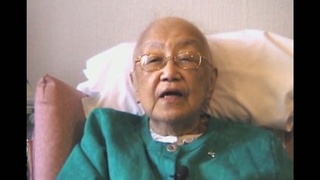Interviews
Decision to settle in Argentina after WWII (Spanish)
(Spanish) I believe that every nihonjin, or Japanese, wanted to [succeed in] America and then afterwards return to Japan to obtain something better. This was everyone’s goal, I believe, the goal of every nihonjin. But after World War II, the majority of the people here did not want to return. Therefore, the people began to buy land [here in Argentina]. Before [they bought land], everything was leased. In the old days, when we were kids, in any town square, moving vans were filled up. After World War II all the nihonjin settled down here [in Argentina] because they already saw that even if they returned to Japan they would be unable to do anything there.
Date: September 18, 2006
Location: Buenos Aires, Argentina
Interviewer: Takeshi Nishimura, Ricardo Hokama
Contributed by: Centro Nikkei Argentino
Explore More Videos


Going back to Hawaii
An expert researcher and scholar on Japanese immigrant clothing.

Picture brides and karifufu
An expert researcher and scholar on Japanese immigrant clothing.

Working at the magazine
(b.1948) Nikkei from Southern California living in Japan.

Kibei schoolchildren in Hiroshima, Japan
(b.1913) Kibei from California who served in the MIS with Merrill’s Marauders during WWII.

The reason he came to the United States (Japanese)
(1949 - 2019) Taiko player. Founded five taiko groups in Southern California

Grandfather's arrival in the U.S., experiencing discrimination
(b. 1939) Japanese American painter, printmaker & professor

Mother's immigration to U.S. as a treaty merchant
(b. 1927) Japanese American Nisei. Family voluntarily returned to Japan during WWII.

Why her parents came to Canada
(1918-2004) Interned in Slocan during World War II. Active member of the Japanese Canadian community.

Family background of Fredrick Yoshihide Sasaki
(b. 1918) Issei businessman in Canada

Arranged marriage
(b.1912) Japanese Canadian Issei. Immigrated with husband to Canada in 1931

Her early life in Canada
(b.1912) Japanese Canadian Issei. Immigrated with husband to Canada in 1931

Coming to America
(b.1943) Shin-issei grand master of taiko; founded San Francisco Taiko Dojo in 1968.

The reason for coming to Japan
(b. 1967) Hawai`i-born professional fighter in Japan

Yobiyose system in Canada
(b. 1922) Canadian Nisei who was unable to return to Canada from Japan until 1952
